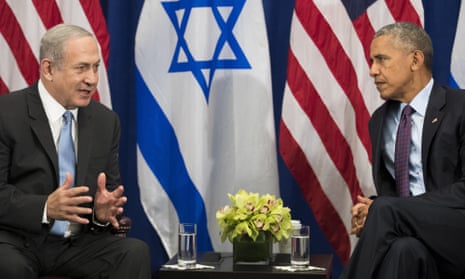President Obama met with the Israeli prime minister, Benjamin Netanyahu, in New York today, with the goal of pressing him to move toward reconciliation with the Palestinians. This comes on the heels of his approval of Israel’s $38bn military aid package, the largest in US history, which many regard as a means to placate Netanyahu over the nuclear agreement the US signed with Iran.
Ironically, it is that very deal, a symbol of the power of international diplomacy, that should serve as an example of how to craft a successful peace agreement between Israelis and Palestinians.
The Iran deal was a historic effort that mitigated Iran’s chances of obtaining a nuclear bomb, a dangerous development many believed was imminent. In exchange for lifting longstanding US and international sanctions, which had crippled Iran’s economy, leaders allowed increased inspections of nuclear facilities, removed two-thirds of the country’s centrifuges and dismantled its plutonium reactor. For the first time in a decade, Iran did not have sufficient enriched uranium to create a nuclear bomb. The deal also created the space to free five US citizens who were being held hostage there and dramatically increased international peace and security.
It worked because the US and Iran understood that to move forward, both had to put something on the table. In addition, the involvement of the other P5+1 countries (France, Russia, United Kingdom, China and Germany) and the European Union was instrumental, since each had their own political and economic relationships with Iran and the US and could obtain buy-in from their national legislatures to ensure the deal’s implementation. Additional partners also increased pressure on Iran to be accountable.
As it stands, Netanyahu does not have much incentive to acquiesce to a peace agreement facilitated by the US alone. Israel has already secured US military aid for the next decade, and Netanyahu has a long track record of overseeing continued construction of settlements and destruction of Palestinian villages, despite US admonishment. From the Palestinian side, negotiators have called bilateral talks “a waste of time” and increasing hopelessness motivates firing rockets from Gaza and knife and car attacks against Israelis in Jerusalem. The first local Palestinian elections in 10 years encompassing both the West Bank and Gaza, which could have advanced national unity, have been suspended.
The two-state solution is at risk of giving way to a “one-state reality of perpetual violence and occupation”, according to the UN secretary general, Ban Ki-moon, speaking recently, on the 23rd anniversary of the Oslo Accords. Gaza, in particular, he said, is a “ticking time bomb” and requires Palestinian unity, ending illicit arms buildup and militant activities and lifting of movement and access restrictions to dismantle it. The secretary general urged international stakeholders to work toward a negotiated end to the occupation, now entering its 50th year, and the establishment of a viable, democratic Palestine which lives in peace with Israel.
Like the Iran deal, economic incentives are probably the most viable means to accomplish such a goal. European officials, in particular, are keen on this strategy, given that the European Union is Israel’s biggest trading partner and the largest donor to the Palestinian Authority, which governs the West Bank. In June, France convened an international meeting attended by countries including Egypt, China, Russia, the UK, Germany and Saudi Arabia to restart talks. The aim was to organize an international conference before the end of the year and develop a package of trade and security incentives to push Israel and Palestinians to peace.
Neither of Obama’s successors is likely to bring about peace on their own. Clinton’s firm support of Israel and Netanyahu is well known, and Trump’s campaign, despite first emphasizing the importance of remaining neutral, recently expressed support for Netanyahu’s claim that removing Israelis from illegal settlements in the West Bank constituted the “ethnic cleansing of Jews”. Palestinians who witness daily evictions of their friends and family and recall the Israeli military forcibly removing 700,000 people from their homes in 1948 would understandably be hesitant to involve such leaders without more neutral parties also at the table.
The nuclear agreement with Iran was seen as a long shot by many. But it ended up becoming a successful modern-day example that bombs and bullets cannot create enduring peace and security the way diplomacy can.
The Israeli/Palestinian conflict is no different. With a building of mutual trust, concessions from both sides, international support and economic incentives, it is certainly possible to finally resolve the conflict for good.
